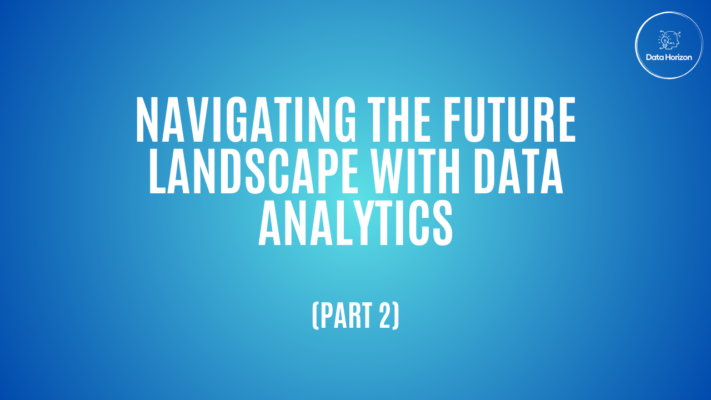Pioneering the Future of Data-Driven Innovation
As we continue our exploration (Read part 1 here) into the future landscape of data analytics, Part 2 delves deeper into actionable insights, practical applications, and forward-looking strategies. By examining real-world examples, emerging technologies, and strategic imperatives, organizations can glean invaluable insights, optimize decision-making processes, and drive sustainable growth in an increasingly complex, interconnected, and dynamic landscape.
Real-World Examples: Charting Success Stories and Transformative Outcomes
To contextualize theoretical frameworks and emerging trends, exploring real-world examples and success stories provides invaluable perspectives and strategic direction. Key considerations encompass:
- Financial Services: Enhancing Risk Management and Regulatory Compliance: Leveraging data analytics, AI algorithms, and blockchain technology, financial services organizations optimize risk management, regulatory compliance, and stakeholder trust. By analyzing market trends, transaction patterns, and regulatory requirements, organizations foster transparency, accountability, and value creation, ensuring alignment with customer expectations, industry standards, and organizational values in an increasingly complex, interconnected, and regulated landscape.
- Energy Sector: Driving Sustainability and Operational Excellence: Embracing data analytics, IoT devices, and renewable energy solutions, energy sector organizations drive sustainability, operational excellence, and market leadership. By analyzing production metrics, resource utilization, and environmental impacts, organizations optimize energy consumption, mitigate risks, and foster innovation, ensuring alignment with regulatory requirements, stakeholder expectations, and industry benchmarks in an increasingly competitive, dynamic, and interconnected landscape.
- Retail Industry: Optimizing Supply Chain, Customer Experiences, and Market Dynamics: Prioritizing data analytics, machine learning algorithms, and personalized marketing strategies, retail industry organizations optimize supply chain, customer experiences, and market dynamics. By analyzing customer behaviors, purchasing patterns, and competitive landscapes, organizations foster loyalty, advocacy, and revenue growth, ensuring alignment with customer expectations, market trends, and industry benchmarks in an increasingly competitive, dynamic, and customer-driven landscape.
Strategic Considerations: Navigating Challenges and Seizing Opportunities
As organizations navigate the future landscape, strategic considerations—spanning challenges, opportunities, and transformations—emerge as paramount. Key considerations encompass:
- Addressing Data Privacy, Security, and Ethical Considerations: Prioritizing data privacy, security, and ethical considerations ensures trust, transparency, and accountability. By implementing robust frameworks, compliance initiatives, and ethical guidelines, organizations foster stakeholder trust, mitigate risks, and ensure alignment with regulatory requirements, industry standards, and societal expectations in an increasingly complex, interconnected, and regulated landscape.
- Embracing Digital Transformation, Innovation, and Agility: Fostering digital transformation, innovation, and agility ensures competitiveness, relevance, and value creation. By embracing emerging technologies, disruptive trends, and transformative strategies, organizations capitalize on opportunities, mitigate risks, and drive sustainable growth, ensuring alignment with evolving business requirements, customer expectations, and organizational values in an increasingly competitive, dynamic, and interconnected landscape.
- Investing in Talent Development, Organizational Capabilities, and Stakeholder Engagement: Prioritizing talent development, organizational capabilities, and stakeholder engagement ensures resilience, agility, and adaptability. By investing in training programs, certifications, and skill-building initiatives, organizations cultivate analytical expertise, thought leadership, and industry recognition, ensuring alignment with evolving business requirements, customer expectations, and organizational values in an increasingly competitive, dynamic, and customer-driven landscape.
Future Outlook: Charting the Course for Tomorrow’s Data-Driven World
In the evolving landscape of data analytics, future outlook—spanning innovation, agility, and strategic foresight—emerges as paramount. Key considerations encompass:
- Harnessing Emerging Technologies, Disruptive Trends, and Transformative Strategies: Prioritizing emerging technologies, disruptive trends, and transformative strategies ensures competitiveness, relevance, and value creation. By fostering a culture of innovation, collaboration, and strategic alignment, organizations capitalize on emerging opportunities, mitigate risks, and drive sustainable growth, ensuring alignment with evolving business requirements, customer expectations, and organizational values in an increasingly competitive, dynamic, and interconnected landscape.
- Navigating Regulatory Compliance, Ethical Considerations, and Societal Expectations: Embracing regulatory compliance, ethical considerations, and societal expectations ensures integrity, transparency, and accountability. By implementing robust governance frameworks, compliance initiatives, and ethical guidelines, organizations foster stakeholder trust, mitigate risks, and ensure alignment with regulatory requirements, industry standards, and societal expectations in an increasingly complex, interconnected, and regulated landscape.
- Investing in Sustainable Practices, Environmental Stewardship, and Social Responsibility: Prioritizing sustainable practices, environmental stewardship, and social responsibility ensures long-term viability, stakeholder engagement, and organizational excellence. By embracing sustainable initiatives, eco-friendly solutions, and community engagement, organizations optimize resource utilization, mitigate environmental impacts, and foster societal contributions, ensuring alignment with regulatory requirements, stakeholder expectations, and industry benchmarks in an increasingly competitive, interconnected, and responsible landscape.
Conclusion
As we conclude our analytical odyssey into the future landscape of data analytics, actionable insights, real-world examples, and strategic considerations illuminate transformative outcomes, insights, and innovations. By fostering strategic considerations, future outlook, and organizational alignment, organizations harness the transformative potential of data analytics, ensuring sustainable growth, competitive differentiation, and organizational excellence in an increasingly complex, interconnected, and dynamic landscape. As we continue this exploration, subsequent segments will delve deeper into emerging trends, innovations, and opportunities, ensuring organizations navigate the future with confidence, clarity, and conviction.
Stay tuned for subsequent posts, where we delve deeper into emerging trends, innovations, and opportunities, ensuring organizations harness the full spectrum of data analytics capabilities, opportunities, and advantages in an increasingly complex, interconnected, and dynamic landscape.
